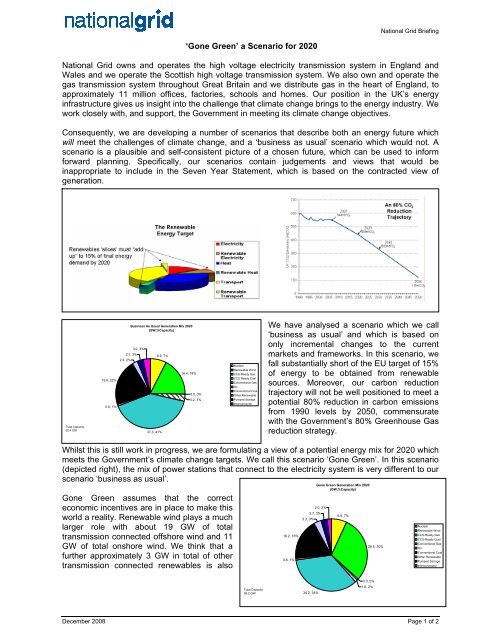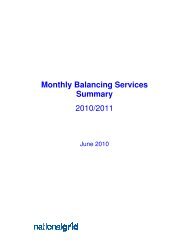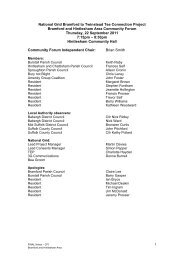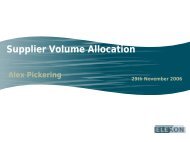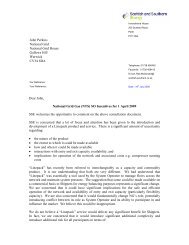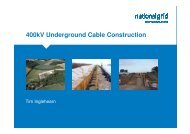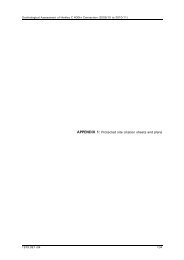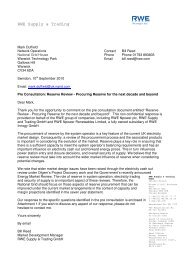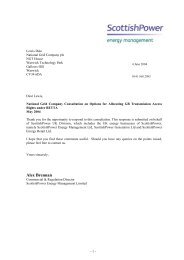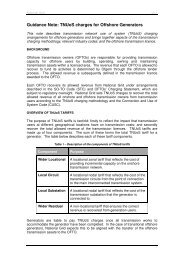'Gone Green' a Scenario for 2020 National Grid owns and operates ...
'Gone Green' a Scenario for 2020 National Grid owns and operates ...
'Gone Green' a Scenario for 2020 National Grid owns and operates ...
You also want an ePaper? Increase the reach of your titles
YUMPU automatically turns print PDFs into web optimized ePapers that Google loves.
‘Gone Green’ a <strong>Scenario</strong> <strong>for</strong> <strong>2020</strong><br />
<strong>National</strong> <strong>Grid</strong> Briefing<br />
<strong>National</strong> <strong>Grid</strong> <strong>owns</strong> <strong>and</strong> <strong>operates</strong> the high voltage electricity transmission system in Engl<strong>and</strong> <strong>and</strong><br />
Wales <strong>and</strong> we operate the Scottish high voltage transmission system. We also own <strong>and</strong> operate the<br />
gas transmission system throughout Great Britain <strong>and</strong> we distribute gas in the heart of Engl<strong>and</strong>, to<br />
approximately 11 million offices, factories, schools <strong>and</strong> homes. Our position in the UK’s energy<br />
infrastructure gives us insight into the challenge that climate change brings to the energy industry. We<br />
work closely with, <strong>and</strong> support, the Government in meeting its climate change objectives.<br />
Consequently, we are developing a number of scenarios that describe both an energy future which<br />
will meet the challenges of climate change, <strong>and</strong> a ‘business as usual’ scenario which would not. A<br />
scenario is a plausible <strong>and</strong> self-consistent picture of a chosen future, which can be used to in<strong>for</strong>m<br />
<strong>for</strong>ward planning. Specifically, our scenarios contain judgements <strong>and</strong> views that would be<br />
inappropriate to include in the Seven Year Statement, which is based on the contracted view of<br />
generation.<br />
Total Capacity<br />
92.4 GW<br />
19.8, 22%<br />
0.8, 1%<br />
2.3, 2%<br />
Business As Usual Generation Mix <strong>2020</strong><br />
(GW,%Capacity)<br />
2.7, 3%<br />
3.0, 3%<br />
37.3, 41%<br />
6.9, 7%<br />
16.4, 18%<br />
0.0, 0%<br />
3.2, 3%<br />
We have analysed a scenario which we call<br />
‘business as usual’ <strong>and</strong> which is based on<br />
only incremental changes to the current<br />
markets <strong>and</strong> frameworks. In this scenario, we<br />
fall substantially short of the EU target of 15%<br />
of energy to be obtained from renewable<br />
sources. Moreover, our carbon reduction<br />
trajectory will not be well positioned to meet a<br />
potential 80% reduction in carbon emissions<br />
from 1990 levels by 2050, commensurate<br />
with the Government’s 80% Greenhouse Gas<br />
reduction strategy.<br />
Whilst this is still work in progress, we are <strong>for</strong>mulating a view of a potential energy mix <strong>for</strong> <strong>2020</strong> which<br />
meets the Government’s climate change targets. We call this scenario ‘Gone Green’. In this scenario<br />
(depicted right), the mix of power stations that connect to the electricity system is very different to our<br />
scenario ‘business as usual’.<br />
Gone Green assumes that the correct<br />
economic incentives are in place to make this<br />
world a reality. Renewable wind plays a much<br />
larger role with about 19 GW of total<br />
transmission connected offshore wind <strong>and</strong> 11<br />
GW of total onshore wind. We think that a<br />
further approximately 3 GW in total of other<br />
transmission connected renewables is also<br />
Nuclear<br />
Renewable Wind<br />
CCS-Ready Gas<br />
CCS-Ready Coal<br />
Conventional Gas<br />
Oil<br />
Conventional Coal<br />
Other Renewable<br />
Pumped Storage<br />
Interconnector<br />
Total Capacity<br />
99.2 GW<br />
Gone Green Generation Mix <strong>2020</strong><br />
(GW,%Capacity)<br />
December 2008 Page 1 of 2<br />
18.2, 18%<br />
0.8, 1%<br />
3.3, 3%<br />
34.2, 34%<br />
2.0, 2%<br />
2.7, 3%<br />
6.9, 7%<br />
.<br />
29.5, 30%<br />
0.0, 0%<br />
1.6, 2%<br />
Nuclear<br />
Renewable Wind<br />
CCS-Ready Gas<br />
CCS-Ready Coal<br />
Conventional Gas<br />
Oil<br />
Conventional Coal<br />
Other Renewable<br />
Pumped Storage<br />
Interconnector
plausible. Examples of these energy sources could be; biomass, wave <strong>and</strong> tidal energy.<br />
<strong>National</strong> <strong>Grid</strong> Briefing<br />
And what of the other contributors to the energy mix? In the world of the ‘Gone Green’ scenario,<br />
similar levels <strong>and</strong> timing of plant closure to that which is in ‘Business As Usual’ are anticipated, albeit<br />
with some additional incremental coal plant closures <strong>and</strong> slightly less new gas CCGT construction<br />
This would result in 35% of our electricity sourced from renewables compared with about 5% today.<br />
We believe that this generation mix, if combined with significant contributions from the domestic heat<br />
sector <strong>and</strong> from the transport sector respectively, could meet the 15% EU target <strong>and</strong> also place us on<br />
the glide path towards the 80% carbon reduction target.<br />
We also see a role <strong>for</strong> Bio-methane as a renewable energy source. This has similar properties to<br />
natural gas with significant potential to supply renewable heat. Injecting biogas into the gas network<br />
effectively reduces the carbon intensity of gas as well as adding to the diversity of fuel sources – thus<br />
improving security of energy supply <strong>for</strong> the UK The biogas method of dealing with waste is a<br />
significantly more environmentally friendly method than most incineration or l<strong>and</strong>fill schemes as it<br />
captures the methane that would otherwise be released to the atmosphere <strong>and</strong> converts it to carbon<br />
dioxide <strong>and</strong> water. As a greenhouse gas, methane is significantly more potent as carbon dioxide.<br />
Consequently, even modest volumes of bio-gas would have a disproportionate <strong>and</strong> favourable impact<br />
under certain conditions.<br />
So what needs to change? In achieving such challenging targets <strong>for</strong> renewable generation, we will<br />
still require the delivery of significant additional transmission capacity, both onshore <strong>and</strong> offshore. We<br />
believe that a regulatory regime needs to be put in place, in order to facilitate more strategic<br />
investment ahead of firm commitments from customers. This is to ensure that network investment<br />
<strong>and</strong> growth in new renewables can happen ‘in parallel’ <strong>and</strong> not ‘in series’. This will ensure that there<br />
is sufficient transmission capacity when new renewable generation wants to connect to the system.<br />
We are developing arrangements to improve access to the transmission system <strong>for</strong> renewables. We<br />
are playing a pivotal role in driving this <strong>for</strong>ward with Government <strong>and</strong> Ofgem within an industry-wide<br />
discussion on re<strong>for</strong>m of these arrangements. Such improvements to the access regime against the<br />
background of future high renewable energy volumes would allow the existing transmission system to<br />
be used efficiently, <strong>and</strong> facilitate the connection of additional renewable generation. It follows also,<br />
that we must coordinate our onshore <strong>and</strong> offshore investment.<br />
In summary, we believe that the Gone Green scenario, whilst extremely challenging, represents a<br />
plausible way <strong>for</strong>ward to meet the climate change challenge <strong>for</strong> <strong>2020</strong>. In preparation, we are helping<br />
to re<strong>for</strong>m the arrangements of accessing the transmission system. However, the challenging<br />
timescales require us, <strong>and</strong> the other transmission owners to invest ahead of firm customer<br />
commitment so that we can proceed to a low carbon future ‘in parallel’, <strong>and</strong> not wait <strong>for</strong> projects to<br />
enter a contractual arrangement with us, thus making the developments happen in series.<br />
December 2008 Page 2 of 2


